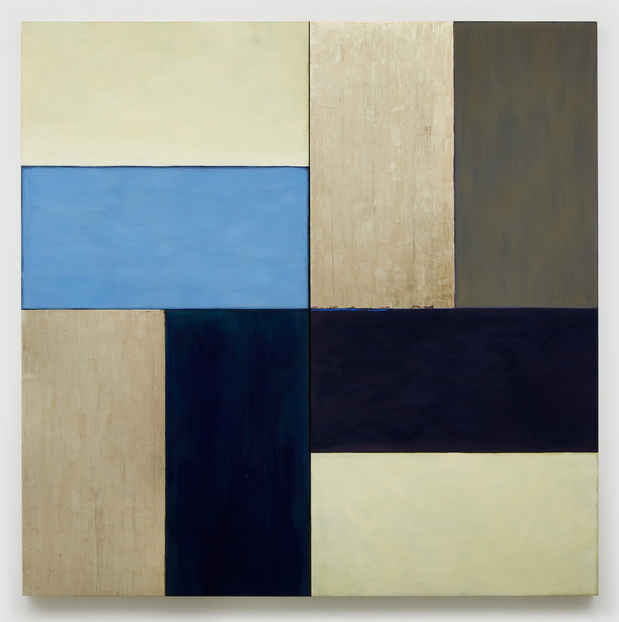Mary Obering “Works from 1972 to 2003”
Bortolami

[Image: Mary Obering "Winter" (992) Egg tempera and white gold leaf on gessoed panels, 84 x 84 in.]
This event has ended.
Surveying Mary Obering’s prolific output from 1972 to 2003, this exhibition focuses on the artist’s singular approach to Minimalism and geometric abstraction. The exhibition stretches across both floors of the gallery, with the Upstairs dedicated to artworks from the 1970s, a nod to the artist’s SoHo studio in which she took residency in 1971.
In the early 1970s, Obering began exploring minimalist painting’s ability to push beyond its internal pictorial space, generating a technique uniquely her own. Works from her Drop Series see cut strips of canvas tacked with finishing nails to the top edge of stretched monochrome canvases, their layering suggesting portals or entryways into landscapes of the artist’s own imagining. Applied in fluttering brushstrokes, the balanced palette of Through Snowy Mountains at Dawn (1973) reveals the artist’s fascination with Eastern art and philosophy, in particular Tang Dynasty poetry. Her Window Series, from this same typology, were one of the first series the artist presented in New York, in an exhibition curated by Carl Andre at Artist’s Space.
Within this same decade the artist abandoned her canvas support, beginning to paint on Masonite panels with a variety of approaches. The Arch Series elaborates on the Renaissance invention of painting as a window onto the world. In Dream Plane (1975), titanium white and a vibrant blue splice two equal curved panels, revealing a horizon line in this simple act, and a tension between what the artist thought of as pure abstraction and the compositional elements of landscape.
Obering’s thematic exploration found fertile ground with the introduction of mediums which would become the artist’s signature over the next four decades: egg tempera and gold leaf. In employing Old Masters techniques, the artist envisioned a blending of architecture and painting; the antique artworks produced with these materials inevitably recalling the churches and buildings in which they were housed. The paintings created with these unexpected materials were presented by some of New York’s most daring and respected galleries in the 1980s and 1990s, Julian Pretto, Annina Nosei, and John Weber. In Archangel from 1990, a rectilinear arrangement reveals the material process generally concealed in the finished work of art, with untreated Masonite, gesso, gilding clay, and graphite given equal weight to lush aquamarine tempera and brilliant gold leaf.
The later production by the artist is represented in a series of jewel-like multi-panel works, Sail On (For Hyde) (1998), Story (1999), and KCB, BKC, CBK (2003). Rhythm is produced through the oscillation and repetition of cascading shapes and tonal shifts across distinct surfaces. An earlier suggestion to push beyond the painting plane is re-visited through the activation of the spaces between the lushly painted panels: the walls themselves. Within the Hanging Series, tempera wraps around the edges and tops of object-like panels, calling to mind Obering’s 1970s invention of draped paintings. The oft-ignored parts of paintings—their edges—are given reverence, gilded and built-up in bright hues, so that the most curious viewer is rewarded in their examination.
Media
Schedule
from January 07, 2022 to February 26, 2022